How Did World War I Change The Nature Of Warfare?
To savor the CBBC Newsround website at its best you lot will need to have JavaScript turned on.
Information technology is 100 years since the end of one of the most significant wars in modernistic history - World State of war I.
It became known as the Bang-up War because it affected people all over the world and was the biggest war anyone had always known.
It even came to be known as 'the state of war to end all wars', every bit no conflict earlier World War Ane had caused destruction on this scale before. People wanted to believe that nobody would ever desire to get to war again after information technology. (Sadly, we know it was not to be the last devastating war that the world would experience).
Millions of people - both soldiers and ordinary citizens - lost their lives. Of those who did come dwelling house from the war, many were injured physically or struggled mentally as a result of what they had experienced.
On 11 November 1918, the guns fell silent and the war came to an terminate, but its impact was felt for many, many years subsequently.
Globe War One changed the world in ways that nobody could have imagined. Here, we accept a wait at how.
New technology
One of the well-nigh pregnant impacts of Earth State of war One was huge advances in engineering science, which would transform the style that people all around the world travelled and communicated, in particular, in the years afterwards the conflict.
New weapons and technologies were adult and used that led to more destruction than any war had seen in the past.
To enjoy the CBBC Newsround website at its best you will need to have JavaScript turned on.
In 1914, planes were still a very new invention. The commencement ane had only taken to the skies but 11 years before!
They were rare and frail, but when war broke out, scientists and engineers worked hard to develop planes that were stronger, quicker and capable of being used in battle.
The first bombs were dropped from the air (by hand at first past the airplane pilot!) and planes were used to spy on enemy territory. It is estimated that it would take a airplane just iv hours to gather the aforementioned amount of information as a patrol on foot could go in 24 hours.
French republic but had 140 aircraft when state of war began, but by the end of it, information technology had used effectually 4,500.
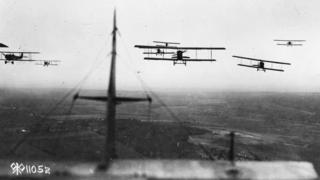 Getty Images
Getty Images
Aviation technology was completely transformed during World War One
It wasn't simply the war in the air that saw huge advances in applied science, though. Special technology to detect German language submarines called U-boats was invented to protect the British Navy - at the time, the largest navy in the earth.
Meanwhile on the land, poisonous gas was being used as a weapon, so gas masks were created to protect soldiers.
Special technology called sound ranging that enabled soldiers to pinpoint where the enemy was from the sound of their gunfire also proved extremely important.
Finally, tanks were also used for the beginning fourth dimension, which could drive across dirty battlefields and burn lethal weapons. U.k. used tanks in battle for the starting time time on 15 September 1916 and, in total, produced around 2,600 of them throughout the war.
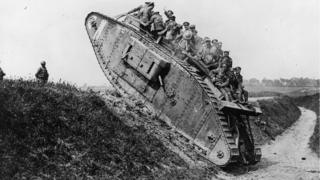 Getty Images
Getty Images
Tanks were able to navigate the difficult terrain of the World War 1 battlefields
It wasn't but weaponry that advanced, though. New methods of photography, sound recording and ways to communicate were developed during the war, which had a long-lasting impact.
Knowing more than most these new technologies and ways of fighting would prove vital for future military machine tactics and in preparations for Earth War Two.
Medical innovation
Wounds inflicted on soldiers were like zippo medical professionals had had to bargain with earlier - not least in terms of the numbers of people injured.
And then the war meant that medicine had to catch up to be able to deal with these problems.
Donating and giving blood started during World War One, when a US army doctor called Captain Oswald Robertson realised that claret needed to exist stockpiled so information technology was there gear up and waiting when casualties arrived.
He set up the get-go blood bank on the Western Front in 1917, using sodium citrate to cease the claret from clotting and becoming unusable.
 Getty Images
Getty Images
This picture shows injured Indian soldiers of the British Ground forces during World War 1 existence treated at the Brighton Pavilion back in the Britain (merged with what the Pavillion looks like at present)
A special rod called a Thomas splint, which was used on soldiers who had broken their leg, was as well developed. At the first of the state of war, 4 in every five soldiers with a broken femur died. By 1916, iv out of five survived.
During World State of war 1, medical professionals and army generals learned many important lessons nigh administering medical assist during warfare.
Financial hardship
War is incredibly expensive - and this war was no different. Just 1 24-hour interval's worth of bullets cost £3.8 million in September 1918.
Before the war, U.k. was in fact the globe's economic superpower, with pregnant levels of wealth and resource.
Just war took its toll and the effect of how much it cost was felt for many years to come. It left much of Europe in severe economical hardship.
Germany, particularly, had to pay an enormous neb of £six,600 million for the damage caused, as well equally provide other compensation.
Role of women
Up until the war, women were perceived in a certain manner in society. Their office was traditionally to stay in the home.
Problems like politics and war were very much seen as things for men to deal with.
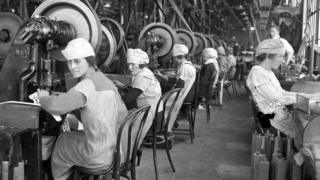 Getty Images
Getty Images
World War One changed the manner that women were seen in society after the contribution they had made to the war effort
In the UK, laws were existence changed to improve women's standing in gild. For instance, they had more rights when it came to their houses and their children, but there was however a long way to go before men and women would be treated more than as.
When state of war broke out and the men went off to fight, information technology was women who took on their jobs and kept things running back in Britain. Across the state, by tardily 1918, ix in every x workers in the munitions industry were female - jobs which traditionally would have been done by men. Women also worked every bit conductors on trams and buses, as typists and secretaries, and on farms.
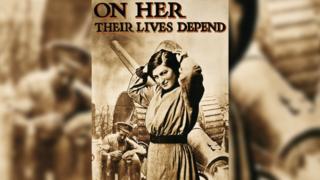 Getty Images
Getty Images
This was ane of the many posters that encouraged women to sign up to piece of work in the munitions factories during Globe War Ane
The war also inverse how many women looked. Trousers appeared for the first time, corsets became increasingly less popular and curt, bobbed hair came into fashion.
Women all the same weren't allowed to exercise all jobs that men did, though, and there was still inequality in terms of wages and the skills they were allowed to learn.
Many women also had to render to a more domestic life when the men came home every bit a event of a law called 1919 Restoration of Pre-War Practices Act. It wasn't until the Second World War in 1939 that many women returned to these industrial jobs.
But in Feb 1918, some women won the correct to vote for the beginning time. Then the Sex Disqualification (Removal) Act of 1919 made information technology illegal to exclude women from jobs because of their gender.
To savor the CBBC Newsround website at its best you will need to have JavaScript turned on.
The contribution made during the war by women was seen an important reason for laws changing, and progress being made in terms of better equality and opportunities for them.
Reshaping of politics
As tin oftentimes be the example following conflict betwixt countries, World State of war One resulted in the political map of Europe being reshaped. Countries' borders moved and there was arguing over who would dominion where.
Nether the Treaty of Versailles which was drawn up after the war to essentially decide what would happen next, Germany lost nearly a tenth of its lands. Farther treaties saw Bulgaria, Republic of austria and Hungary all lose territory too.
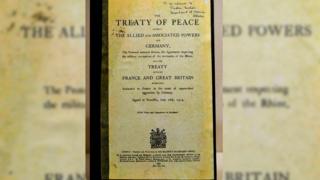 Getty Images
Getty Images
This is a copy of the original Versailles Treaty signed on 28 June 1919
World War One spelled the end of the Ottoman Turkish empire and also contributed to the Russian revolution, which marked the commencement of a new politics system in activeness - communism.
Even today, countries disagree over who should exist in accuse of certain areas, merely Earth War I certainly had a large impact on how Europe's political map was fatigued.
Contribution to Globe State of war Two
It is not accurate to say that World State of war I was a cause of World State of war 2, but it is accepted that the punishments put on Deutschland a issue of the Treaty of Versailles after Earth State of war One contributed to the causes of it.
In 1919, this treaty imposed harsh terms on Germany forcing them to take the blame for the war and pay huge sums for the damages of the war, as outlined above.
Germany was shocked by how strict the treaty was. Information technology was humiliating and many people wanted revenge.
At a time when the state was politically unstable and extremely poor, it was the perfect climate for Adolf Hitler (who led the Germans in World War Two) to rising to power past telling the German people what they wanted to hear and making big promises to them.
Earth War Ii began in 1939 and lasted until 1945.
If yous cannot run across the interactive activity on this page, click here.
Source: https://www.bbc.co.uk/newsround/45966335
Posted by: chavezhond1975.blogspot.com

0 Response to "How Did World War I Change The Nature Of Warfare?"
Post a Comment